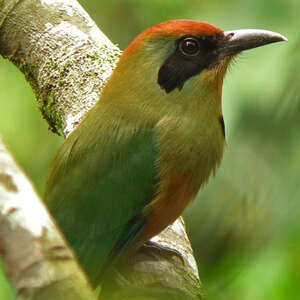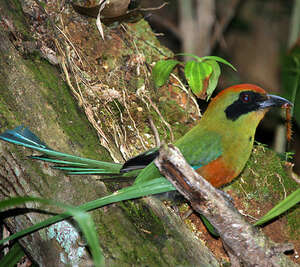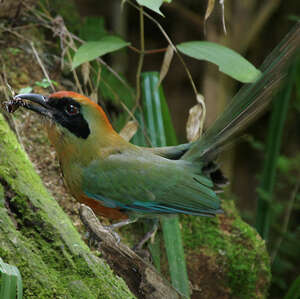Rufous-capped Motmot
Baryphthengus ruficapillus - Motmot oranroux
Identification
Baryphthengus ruficapillus, the scientific name of the Rufous-capped Motmot, can be translated as deep voiced motmot with a rufous head. The identification of our Rufous-capped Motmot was catalogued in 1818 and is attributed to the French ornithologist Louis Jean Pierre Vieillot (1748-1831) who located it in Peru! In fact, two explorers, naturalists, and ornithologists are to be credited with the discovery of the Rufous-capped Motmot; Félix Manuel de Azara, Spanish explorer (1746-1821) explored in Brazil from 1781 to 1801 and discovered Baryphthengus ruficapillus, followed by François Levaillant, French ornithologist (1753-1824) who reworked the findings of his Spanish colleague to cite and give the French name. The Rufous-capped Motmot is a close cousin of the Rufous Motmot, with which it forms the genus Baryphthengus, large in size, 42 cm, with a long, black beak slightly serrated and extended by a thick, black loral stripe that completely surrounds the eye with an amber iris. The bird, like all motmots, appears masked; a thin blue-turquoise eyebrow outlines the mask, the forehead and the cap are a magnificent rufous which gives its name to the Rufous-capped Motmot, the nape and mantle are olive-green while the back and coverings are green tending to khaki. The primary remiges are blue-turquoise. The chin is slightly tinged with rufous while the throat and chest are olive-green, two black points mark the chest and are a remarkable element of the Rufous-capped Motmot like all motmots. A wide light rufous band marks the ventral part under the chest, the abdomen turning again to blue-green, the outer rectrices are grayish while the central rectrices retain a blue-to-blue-green hue, it should be noted that the Rufous-capped Motmot does not have racket tips at the end of the tail. There is no dimorphism, juveniles, rarely observed, are duller than their parents.
Subspecific information monotypic species
Foreign names
- Motmot oranroux,
- Momoto yeruvá oriental,
- juruva-verde,
- Rotkopfmotmot,
- rozsdás motmot,
- Roodkopmotmot,
- Motmot caporossiccio,
- rosthuvad motmot,
- Brunkronemotmot,
- momot hrdzavohlavý,
- momot rezavohlavý,
- Rustbåndet Motmot,
- punamomotti,
- motmot de coroneta rogenca,
- piłodziób rdzawogłowy,
- rjasti motmot,
- Красноголовый момот,
- オオハチクイモドキ,
- 棕顶翠鴗,
- rosthuvad motmot,
- 褐頂翠鴗,
Voice song and call
Habitat
Dietfeeding habits
This formidable predator, primarily an insectivore, will feed on insects and their larvae, as well as amphibians, small reptiles, molluscs and all kinds of small mammals such as opossums. Like the Rufous-capped Motmot, it follows armies of ants in order to snatch their prey! From time to time, it will vary its diet with some fruits.
Reproduction nesting
The Rufous-capped Motmot digs its nest, or rather its burrow, approximately one meter in length, in soft embankments from January to April, often after heavy rains of the Brazilian summer. The incubation of 2 to 3 eggs probably takes place in September-October, parents have been observed feeding their brood in November and juveniles flying around nests in December.
Geographic range
Threats - protection
IUCN conservation status
concern
in the Wild
threatened
evaluated
The Rufous-capped Motmot, LC, is not yet considered endangered by Birdlife, but deforestation has been decreasing its population by decreasing its range and fragmenting its territory; national parks, like the Iguazu National Park in Argentina, remain its favoured refuges.
Sources of information
- IOC World Bird List (v15.1), Gill, F and D Donsker (Eds). 2025-12-07.
- Vol. 6 - Handbook of the Birds of the World, Josep del Hoyo-Andrew Elliott-Jordi Sargatal
- Scientific Birds Names, James A.Jobling
- A Field Guide to the Birds of Brazil, Ber Van Perlo
- xeno-canto, Sharing bird sounds from around the world,
- Avibase, Lepage Denis
- BirdLife International, BirdLife International
- HBW Alive,
- The internet Bird Collection,
- Wikipédia, Wikipedia, The Free Encyclopedia
Other sources of interest
 Specification sheet created on
02/08/2023 by Anne et Gabriel Leboff
Specification sheet created on
02/08/2023 by Anne et Gabriel LeboffTranslation by AI Oiseaux.net
© 1996-2025 Oiseaux.net
- Accipitriformes
- Aegotheliformes
- Anseriformes
- Apodiformes
- Apterygiformes
- Bucerotiformes
- Caprimulgiformes
- Cariamiformes
- Casuariiformes
- Charadriiformes
- Ciconiiformes
- Coliiformes
- Columbiformes
- Coraciiformes
- Cuculiformes
- Eurypygiformes
- Falconiformes
- Galliformes
- Gaviiformes
- Gruiformes
- Leptosomiformes
- Mesitornithiformes
- Musophagiformes
- Nyctibiiformes
- Opisthocomiformes
- Otidiformes
- Passeriformes
- Pelecaniformes
- Phaethontiformes
- Phoenicopteriformes
- Piciformes
- Podargiformes
- Podicipediformes
- Procellariiformes
- Psittaciformes
- Pterocliformes
- Rheiformes
- Sphenisciformes
- Steatornithiformes
- Strigiformes
- Struthioniformes
- Suliformes
- Tinamiformes
- Trogoniformes



















